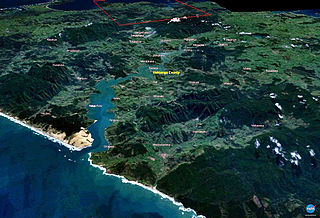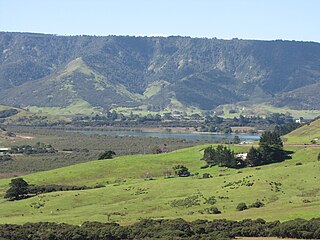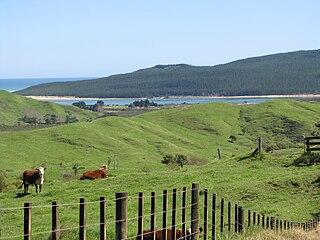
SS Elingamite was an Australian passenger steamer of 2,585 tons, built in 1887, and owned by Huddart Parker. The ship was wrecked on 9 November 1902 off the north coast of New Zealand carrying a large consignment of gold. Now the Elingamite wreck is a favourite site for adventurous divers because of the drama associated with it, and wild tales of lost treasure.

The Hokianga is an area surrounding the Hokianga Harbour, also known as the Hokianga River, a long estuarine drowned valley on the west coast in the north of the North Island of New Zealand.

Ngāpuhi is a Māori iwi associated with the Northland regions of New Zealand centred in the Hokianga, the Bay of Islands, and Whangārei.
The following lists events that happened during 1902 in New Zealand.

Kohukohu is a village on the Hokianga Harbour in the Northland Region of New Zealand. It was one of the first European settlements in New Zealand.
Herald was a 55-ton schooner that was launched on 24 January 1826 at Paihia in the Bay of Islands, New Zealand. While Herald was the first sailing ship built in New Zealand, a small vessel named Providence was constructed in Dusky Sound in 1792–93 by the crew of a sealing ship and it was completed in January 1796 by the crew of another sealing ship that had been wrecked at Dusky Sound in the previous year. In October 1827, the 40-ton schooner Enterprise was completed in the Horeke shipyard in the Hokianga Harbour. Enterprise was wrecked in a storm north of Hokianga Heads on 4 May 1828 with the loss of all hands. Two days later the Herald was wrecked on the Hokianga bar.

Ahipara is a town and locality in Northland, New Zealand at the southern end of Ninety Mile Beach, with the Tauroa Peninsula to the west and Herekino Forest to the east. Ahipara Bay is to the north west. Kaitaia is 14 km to the north east, and Pukepoto is between the two.

Herekino is a locality in Northland, New Zealand. It lies 26 km south west of Kaitaia. The Herekino Harbour, also called the Herekino River, is an estuary and inlet from the Tasman Sea to the west. The Herekino Forest, which contains a stand of large kauri, is to the north, and the Tauroa Peninsula lies to the north west.
Mangamuka is a district in Northland, New Zealand, at the junction of the Mangamuka and Opurehu Rivers. State Highway 1 runs through the area, and the settlement of Mangamuka Bridge lies at the point where the highway crosses the Mangamuku River. The river runs into the upper Hokianga Harbour. Just to the north west, the highway runs through Mangamuka Gorge in the Maungataniwha Range. Umawera lies to the south east.

SS Tararua was a passenger steamer that struck the reef off Waipapa Point in the Catlins on 29 April 1881, and sank the next day, in the worst civilian shipping disaster in New Zealand's history. Of the 151 passengers and crew on board, only 20 survived the shipwreck.
Whirinaki is a locality on the Whirinaki River in the south Hokianga, in Northland, New Zealand. The name means "to lean against a support". Highway 12 runs through it. Opononi lies to the south west, and Rawene lies to the north east.

Whangape Harbour is a harbour on the west coast of Northland, New Zealand. There is a settlement called Whangape on the northern side of the harbour. Another, called Pawarenga, is located on the southern side. Kaitaia is 42 km north east.
Panguru is a community in the northern Hokianga harbour, in Northland, New Zealand. The Whakarapa Stream flows from the Panguru Range in the Warawara Forest to the west, through Panguru and into the Hokianga.

Te Rarawa is a Māori iwi of Northland, New Zealand. The iwi is one of five Muriwhenua iwi of the far north of the North Island.

Te Roroa is a Māori iwi from the region between the Kaipara Harbour and the Hokianga Harbour in Northland, New Zealand. They are part of the Ngāti Whātua confederation of tribes.
Hone Tana Papahia was a New Zealand Anglican clergyman, missionary. Of Māori descent, he identified with the Ngāpuhi iwi and Te Horohuhare and Ngati Haua hapū of Te Rarawa iwi. He was the son of Wiremu Tana Papahia. He was born in Orongotea on the north-west shore of the Hokianga Harbour in about 1856.

Choie Sew Hoy also known as Charles Sew Hoy was a New Zealand merchant, Chinese leader, gold-dredger and a New Zealand Business Hall of Fame laureate. He was born in the village of Sha Kong in the Poon Yu District of Guangdong Province, China in about 1838.
Mitimiti is a small settlement in Northland, New Zealand. It lies close to the Warawara Forest, between the mouths of the Whangape Harbour and Hokianga Harbour on Northland's west coast, 44 km west of Kohukohu. Mitimiti is part of the Hokianga North statistical area. For demographics of this area, see Panguru.
Piripi Kingi Karawai Patiki was a teacher and missionary, who was blind. Of Māori descent, he was a rangatira (chief) of the Ngāpuhi iwi (tribe). He was born near Titoki in the Mangakahia Valley, Northland, New Zealand. Sir William Martin, the first chief justice of New Zealand, said of Piripi Patiki that he resembled the well-known bust of Socrates.













